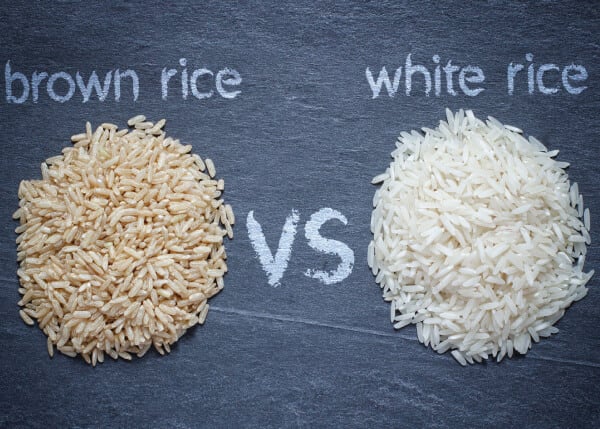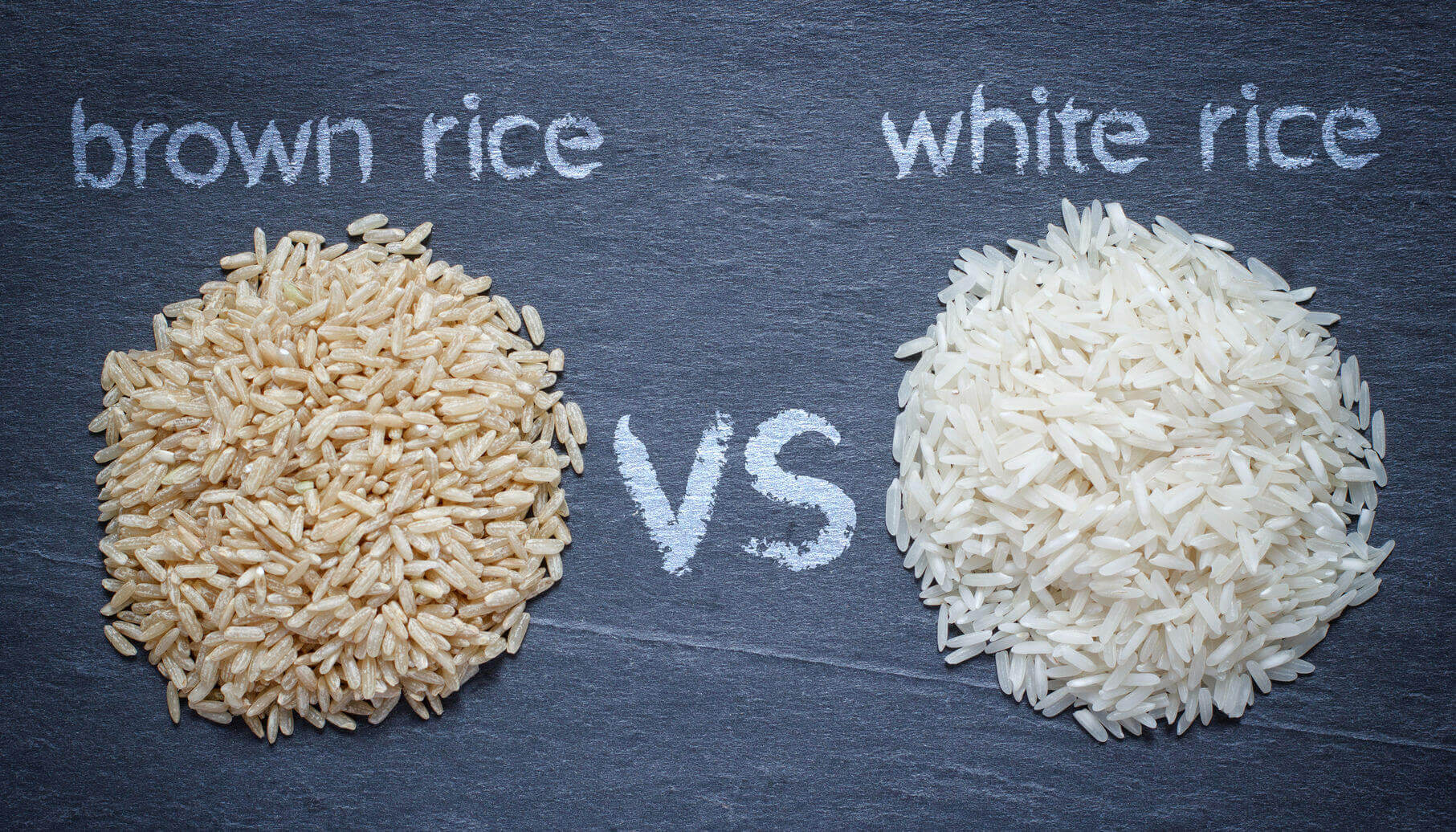Is Brown Rice or White Rice Better For You?

Rice is a common ingredient that transcends cultures, flavor profiles and diet types. In healthy diets, brown rice is viewed as a healthier whole grain choice, whereas white rice is viewed as a refined and processed grain that should be avoided on a diet plan. Since both types of rice often come from the same grain are brown rice and white rice really that different from each other? In this post we put brown and white rice head to head to see how they compare in categories:
-
White Rice vs Brown Rice Table of Contents:
- Difference Between White and Brown Rice
- Processing Rice
- Nutritional Content of Brown vs White Rice
- Health Characteristics of Rice
- Rice in Weight Loss Diets
- Rice for Muscle Gain
- Conclusion White vs. Brown Rice

Brown Rice vs. White Rice
Difference Between Brown and White Rice
There are many types of white rice and brown rice. Brown rice can come from short-grain, long-grain, jasmine, risotto, and basmati varieties. White rice comes from the same types of rice but is processed in a different fashion. Brown rice can be viewed as a “whole-grain” because it is harvested with its outer layers intact. White rice is processed to remove the bran and germ part of the grain. This changes the flavor profile and makes brown rice a nuttier and chewier texture whereas white rice tends to be fluffier with a milder tasting flavor.
There is a negative stigma surrounding processed foods and processed that whole grains are better than refined grains, most will automatically assume brown rice has more benefits than white rice. However, rice is not a heavily processed food, and the differences between the two types of rice rice may be surprising.
How is Rice Processed?
Like everything, rice goes through some processing. The main difference between white rice and brown rice is that white rice gos through a step of processing called milling. (1)
1) Brown rice is created when the outer hull of the grain is removed – this layer is hard and inedible. But the bran and germ layers remain intact with the grain, allowing brown rice to be considered a whole grain.
2) The next step of milling removes the bran layer, leaving only the soft interior that we know of as white rice, which is technically a “refined grain” item at this point. Actually, this type of processed white rice is preferable for people following a inflammatory bowel disease diet plan since more processed foods are less likely to trigger flares. Anybody with damaged intestine can benefit from a more refined food.
Since white rice has the bran layer removed during milling this is easier to digest, making it a good choice for people with Crohn’s, Colitis or other inflammatory bowel diseases.
At times the grain (hull intact) is parboiled prior to milling. This process involves soaking the rice in water and steaming it under intense pressure, making the rice hold together better during milling, but can also push nutrients from the bran layer into the kernel – leaving more nutrition in the white, fluffy interior. (2) This is why the processing of rice can affect the nutritional value.
Definition: Parboiled rice was already partially cooked. This rice is soaked in water and is pressure steamed. This can push nutrients from the bran layer into the kernel, resulting in a more nutritious white rice. Parboiled rice has faster cooking times since it was already pre-cooked.
Neither white or brown rice are heavily processed. Both are naturally gluten-free and don’t contain any added ingredients or preservatives.
Brown vs. White Rice Nutrition
Fundamentally, white rice starts off as brown rice then has the bran layer removed during a process called milling. Therefore, the nutritional value of the bran layer will not be found in white rice. An eight ounce serving yields the following nutritional values:
| Nutrition | Brown Rice | White Rice |
|---|---|---|
| Calories | 256 | 294 |
| Fat | 1.8g | 0.4g |
| Carbohydrates | 52g | 66g |
| Fiber | 4g | 0.6g |
| Protein | 5.2g | 5.4g |
Brown rice is a good source of Magnesium, Thiamine and Niacin. White rice is not naturally a good source of any vitamins and minerals, but contains trace amounts of very similar nutrients. However, white rice is always sold as enriched white rice – meaning vitamins and minerals are added back to the rice. Because of this, enriched white rice may actually have more nutritional value than brown rice.
Enriched Rice Definition: Enriched rice has vitamins and minerals added to it.
While there are differences between rice varieties, brown rice can provide small amounts of fiber, protein and essential nutrients making it a decent source of quality carbohydrates. There is also some debate around whether or not the phytic acid content of the bran layer in brown rice impacts the absorption of certain nutrients, like iron and zinc (4,5). While phytic acid is not a major concern for those who eat a balanced diet, it is an important consideration when comparing brown to white rice nutrition, since white rice has significantly less phytic acid.
Phytic acid Definition: Phytic acid is a substance found in certain plants that are thought to negatively impact mineral absorption (6).
Removing the outer layers of the grain eliminates some of the fiber and fat from the rice and leaves a soft fluffy interior – this allows for white rice to have more carbohydrates (aka sugar) than brown rice. But nutritionally they aren not that different, especially if the white rice has been fortified and phytic acid content is considered.
Health Benefits of Rice
Whole grains like brown rice, are associated with a range of health benefits (7,8). But what about rice in specific and are there any special health advantages to choosing brown over white rice? There is research that has linked white rice consumption to poor blood sugar control and increased risk of type 2 diabetes, mainly because of its high glycemic index (9,10). But in one smaller study, white rice consumption was actually shown to help decrease the risk of diabetes (11). Brown rice is associated with positive health benefits including better blood sugar control and reduced risk of diabetes when consumed in place of white rice (12). Another study suggested that swapping in brown rice promotes better heart health (13). Additional research suggests that the bran layer of brown rice may be a source of powerful plant-based chemicals, called phytochemicals, that provide unique protective health benefits to the food, such as improved heart health and antioxidant effects (14). So, is white rice or brown rice healthier: Brown rice appears to have the slight edge in this area. If you are a person that enjoys eating a lot of rice you may want to include some brown rice in your mix.
How Does Rice Affect Weight Loss?
Weight loss is mainly associated to calorie control, not which type of rice you eat. But that being said, the foods you choose can make sticking to your diet feel easier sometimes – especially if they help manage hunger, energy, and mood. And as it turns out rice intake, in general, may support weight loss when included as part of a nutrient-dense, calorie-controlled diet. Some studies suggest that whole grain consumption is associated with lower body weights and better weight management due to their high fiber and protein content (15,16). Other studies looking at populations who consume high amounts of white rice suggest that white rice may have weight loss benefits as well (17,18,19). To conclude the consumption of rice in a weight loss diet this can be incorporated or left out. Prioritize portion control when talking about weight management. All types of white and brown rice can be associated with negatively or positively with weight loss. If you enjoy rice, opt for the variety you like best and use portion control as well as a balanced approach to eating for weight loss, and you’ll get results.
Rice and Muscle Building
Similar to weight loss, caloric intake is the most important factor when it comes to gaining muscle mass. However, quality carbohydrates from foods like rice can support muscle-building efforts a few different ways. Higher carb intake typically supports more glycogen storage in muscles, which helps fuel your workouts (20). In addition, carbs promote an insulin response, which is beneficial to weight gain (21). White rice has a small advantage with its lower glycemic index and higher carb content, making it slightly better for pre and post-workout meals to promote quick access to nutrients for energy and recovery. But the difference between the two is minor, and for most people, brown rice works just as well. The verdict on rice for muscle building is that Many bodybuilders and athletes prefer white rice because of its higher sugar content and faster absorption to support training and muscle growth, but there isn’t any research to suggest brown rice is inferior for these purposes. Muscle gain is more strongly influenced by total intake and training.
White Rice vs. Brown Rice Conclusion
| Category | Most Beneficial |
|---|---|
| Processing | Tie |
| Nutrition | Tie |
| Health | Brown Rice |
| Weight Loss | Tie |
| Muscle Gain | White |
| Overall | Tie |
Both white and brown rice can be cooked in a pot or rice can be cooked in a rice cooker with different seasoning and spices that change nutritional value. However, assuming the brown and white rice are cooked the same way we can say that brown rice may have more health benefits due to its phytochemical composition, but when it comes to overall nutrition and fitness, it probably doesn’t matter much what type of rice you eat as long as you pay attention to your diet overall.
Want to include brown or white rice as a part of your weekly meal prep? Cut down on cooking and crush your weekly macros with MealPro’s delivered meal plans.
Sources: 1, 2, 3, 4, 5, 6, 7, 8, 9, 10,11,12,13,14,15,16,17,18,19,20,21.